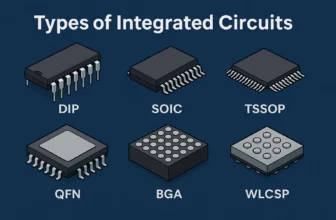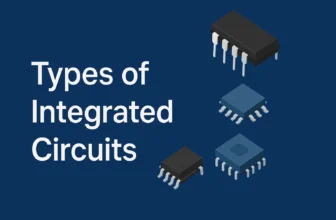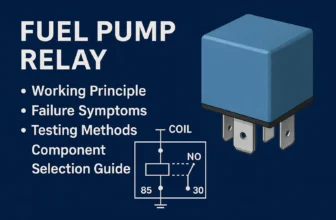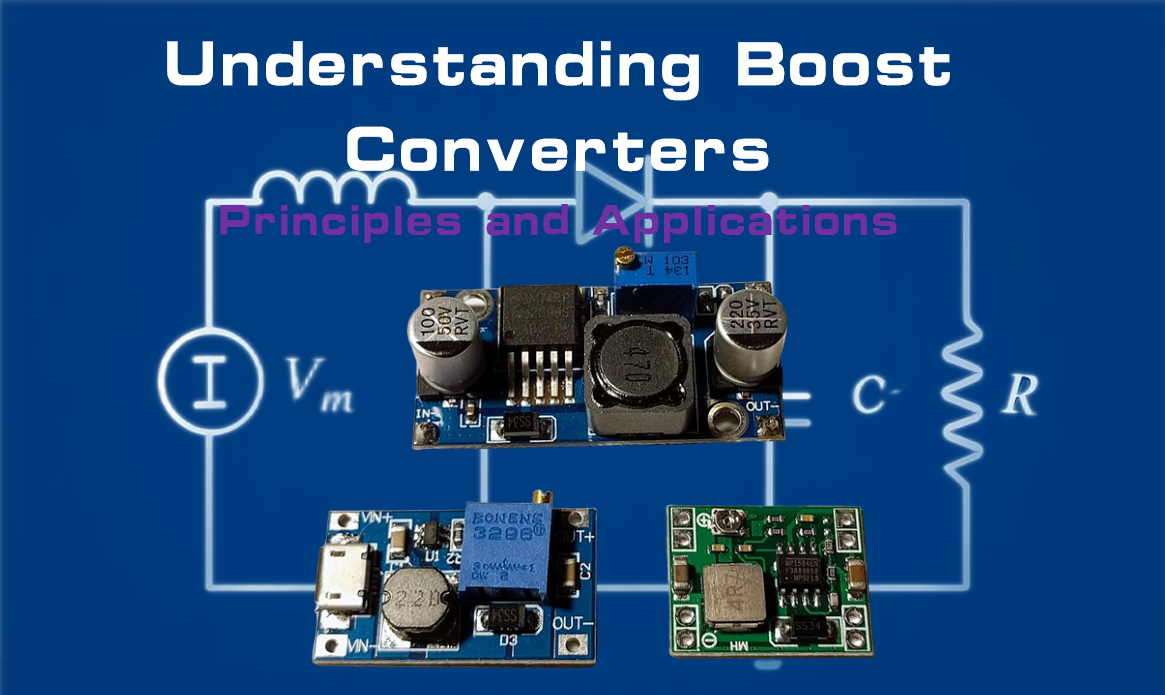
Boost converters are essential in modern electronics. They step up voltage from a lower level to a higher one. This makes them crucial for many applications.
Understanding how they work is vital. It involves knowing their principles and components. These include inductors, switches, diodes, and capacitors.
Boost converters are used in various fields. They power battery-operated devices, solar systems, and electric vehicles. Their ability to increase voltage is invaluable.
The operation of a boost converter is fascinating. It stores energy in an inductor and releases it at a higher voltage. This process is efficient and effective.
Designing a boost converter requires careful planning. Component selection is key to ensuring performance and reliability. This makes them a staple in power supply systems.
Boost converters are versatile. They can be integrated into complex power management systems. This flexibility makes them indispensable in electronics.
Learning about boost converters opens up new possibilities. It helps in designing efficient and sustainable technologies. This knowledge is beneficial for enthusiasts and professionals alike.
In this guide, we will explore boost converters in detail. From principles to applications, we cover everything you need to know.
What is a Boost Converter?
A boost converter is a type of DC-DC converter. It increases a lower input voltage to a higher output voltage. This process is essential in many electronic devices.
The name “boost” signifies the increase in voltage. By stepping up the voltage, it satisfies the needs of various applications. This is crucial for devices with specific voltage requirements.
Key components of a boost converter include:
- Inductor
- Switch (often a transistor)
- Diode
- Capacitor
These components work together harmoniously. The inductor stores energy when the switch is on. Once the switch is off, the energy is transferred to the load.
A boost converter is widely used in battery-powered systems. It allows devices to operate efficiently even when the battery voltage drops. This capability extends the usefulness of portable gadgets.
Boost converters are also found in renewable energy applications. They optimize the voltage from solar panels or wind turbines. This ensures consistent and reliable power delivery to the system.
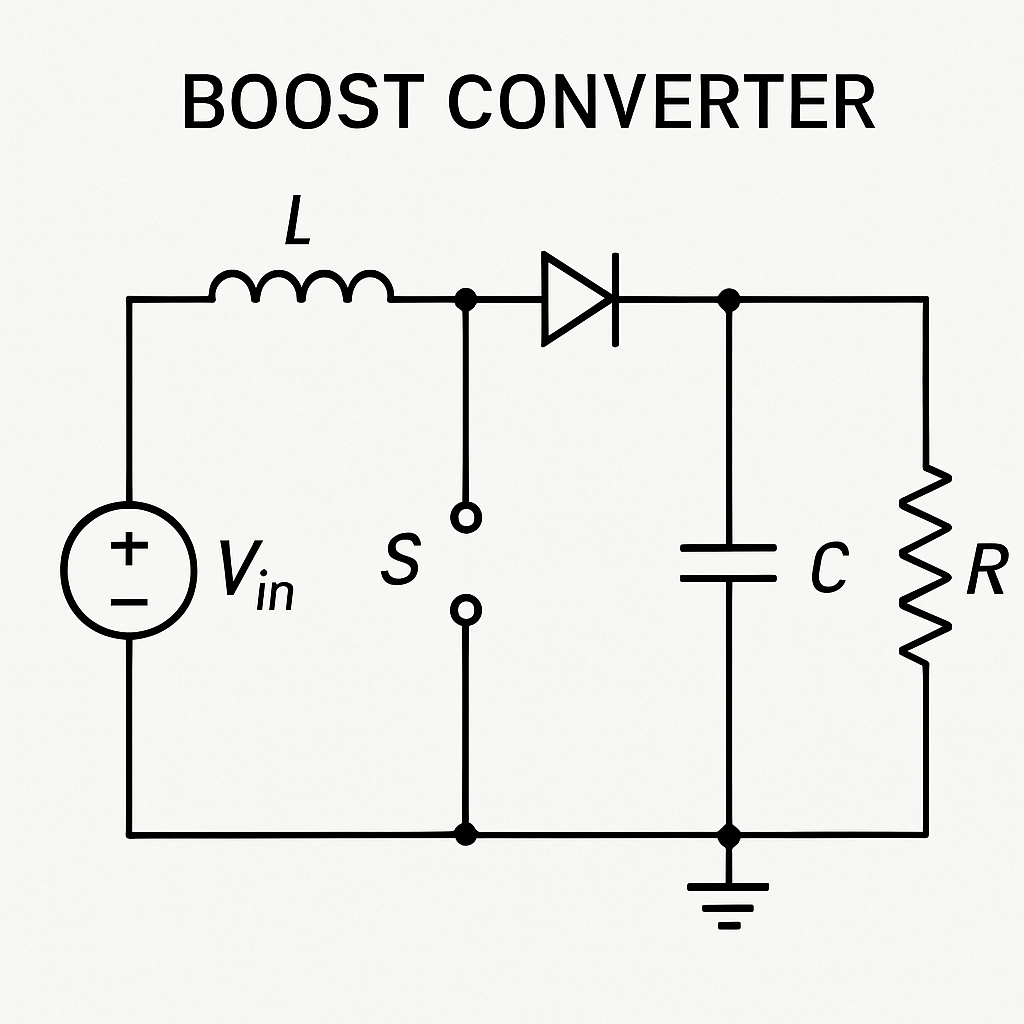
Understanding boost converters involves grasping their basic operation. Energy is accumulated in the inductor and released at a higher voltage. This boosts the voltage while maintaining current flow continuity.
The simplicity and effectiveness of boost converters make them popular. They are simple to integrate into existing systems. This adds to their value as a fundamental component in power electronics.
Their ability to increase voltage efficiently is unmatched. This efficiency is why they are preferred in many sectors. From consumer electronics to industrial applications, their role is pivotal.
A boost converter transforms low voltage to the desired level. This transformation is both efficient and essential. With this understanding, one can appreciate their vast applications.
How Does a Boost Converter Work?
A boost converter operates on a simple principle. It uses an inductor to store and transfer energy. This stored energy is then used to increase the voltage.
The key to its operation is the switching mechanism. The switch, typically a transistor, toggles between on and off states. This process allows the inductor to store energy in the on state.
When the switch turns off, the inductor releases the stored energy. This energy is then directed toward the output. The diode ensures that the energy flows in the correct direction.
Several stages define the operation of a boost converter:
- On State: The switch closes, allowing current to flow through the inductor.
- Off State: The switch opens, causing the inductor to release energy.
- Output Stage: The released energy combines with the input to produce higher output voltage.
The cycle repeats rapidly, often thousands of times per second. This rapid cycling results in a steady increase in voltage. The frequency of switching affects the performance and efficiency.
Efficiency in a boost converter depends on several factors. These include component quality and switching frequency. Properly designed, a boost converter can achieve high efficiency, often above 90%.
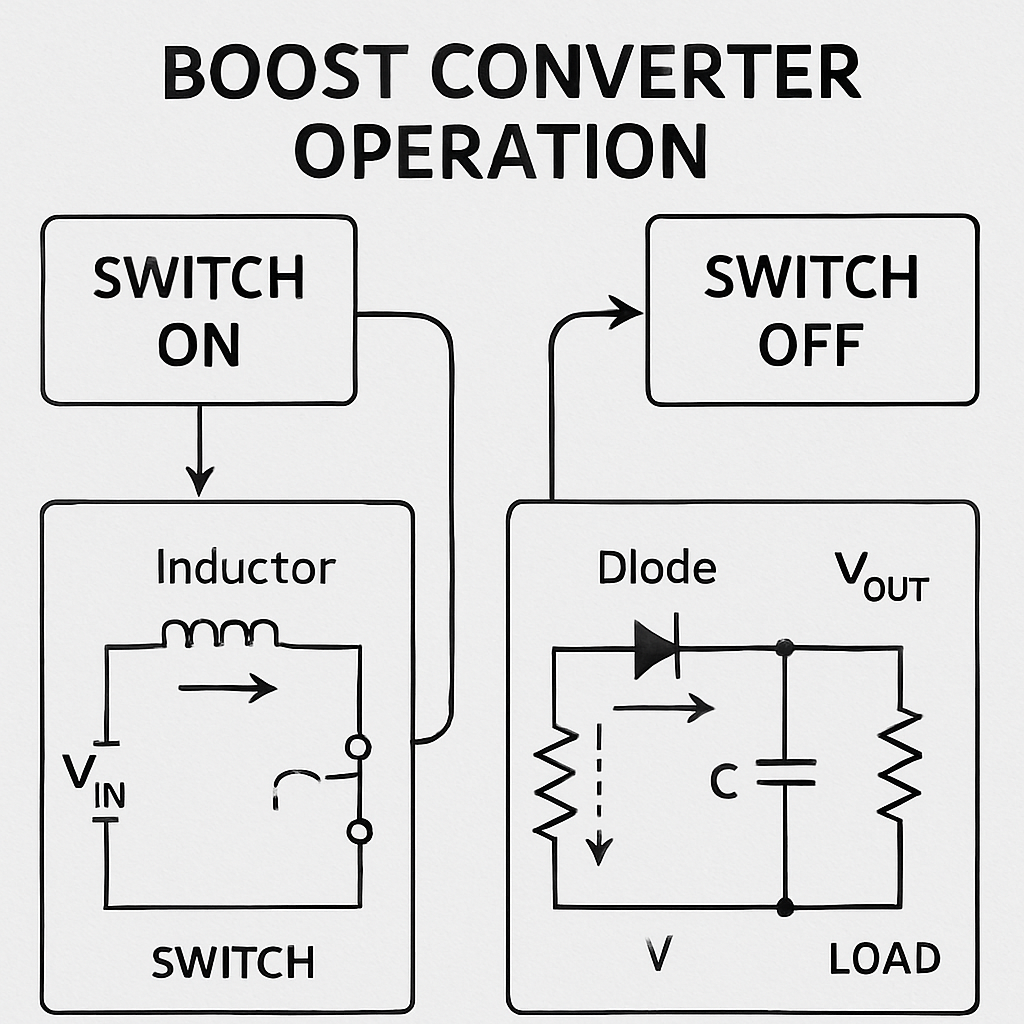
The design of the boost converter circuit must ensure smooth operation. This involves selecting suitable components and choosing correct operating conditions. These decisions directly influence the converter’s reliability.
Controlling the output voltage is crucial in a boost converter. This is often managed by a Pulse Width Modulation (PWM) controller. The PWM adjusts the duty cycle, fine-tuning the output voltage.
Understanding how a boost converter works is essential for anyone in electronics. It forms the basis for many power supply solutions. With this knowledge, designing and troubleshooting these circuits becomes more accessible.
Key Components of a Boost Converter Circuit
A boost converter comprises several critical components. These components function together to achieve voltage conversion efficiently. Each plays a specific role in the overall operation.
The essential parts of a boost converter circuit include:
- Inductor: Stores energy when current flows through it.
- Switch (usually a transistor): Enables energy storage and release.
- Diode: Directs energy flow, preventing backflow.
- Capacitor: Smoothens the output voltage.
- Controller (e.g., PWM): Regulates the operation to maintain stable output.
The inductor is vital. It temporarily stores energy during the on state. It helps to increase the voltage during the off state. Its size and type affect the converter’s performance.
The switch toggles between conducting and non-conducting states. A transistor often serves as the switch. This component controls when energy is stored and released.
A diode plays a protective role. It ensures current flows correctly, preventing it from moving backward. This feature is crucial for maintaining circuit integrity.
Capacitors smooth the output voltage, eliminating fluctuations. They store charge and release it as needed. This action ensures a constant voltage supply to the load.
A controller, such as a Pulse Width Modulation (PWM) unit, adjusts the switching frequency and duty cycle. It keeps the output voltage stable, despite changes in load or input.
Understanding these components’ roles enhances circuit design. This knowledge allows for better performance tuning. Choosing suitable components is necessary for efficient energy conversion.
Each component type and size affect the circuit’s efficiency, reliability, and size. Thoughtful selection and design ensure a robust and effective boost converter.
Boost Converter Schematic and Operation Modes
A boost converter’s schematic is a blueprint showing its components and connections. Understanding this schematic is crucial for building and analyzing the circuit effectively. It provides a visual guide to the converter’s layout.
The schematic outlines all components, such as the inductor, switch, diode, and capacitor. Each has a specific position and function. The connections between these components define the flow of current and energy.
Operation modes of boost converters vary based on component states. Mainly, two modes exist: Continuous Conduction Mode (CCM) and Discontinuous Conduction Mode (DCM). Each mode affects the converter’s behavior and efficiency.
In Continuous Conduction Mode (CCM), the inductor current never falls to zero during a switching cycle. This mode is efficient for high-power applications. It ensures a steady energy flow but requires larger components.
Discontinuous Conduction Mode (DCM) occurs when the inductor current falls to zero at any point. This mode is common in low-power applications. It allows for smaller component sizes but can lead to higher ripple in output voltage.
The transition between these modes depends on the load and duty cycle. Understanding these modes helps optimize the boost converter’s performance for specific applications.
A typical schematic will include:
- Inductor connected to the input voltage.
- Switch connected in series with the inductor.
- Diode placed to direct current to the output load.
- Capacitor across the output terminals to stabilize voltage.
Recognizing how the components interact in these modes is critical. It enables precise adjustments and troubleshooting. Proper schematic interpretation ensures reliability and efficiency in practical applications.
Tailoring the boost converter through these modes allows for flexibility. It enhances performance and integrates seamlessly into various electronic systems. Adjusting operation modes suits different power requirements and optimizes energy use.
Step-Up Converter Circuit: Design and Analysis
Designing a step-up converter circuit involves careful consideration of various parameters. This includes selecting the right components and understanding their roles. Each part plays a crucial function in stepping up the voltage efficiently.
Start by choosing an inductor with sufficient inductance and current capacity. An underperforming inductor can lead to inefficiencies and reduced performance. Moreover, the inductor helps in storing and transferring energy.
Next, the switch, often a transistor, must handle the anticipated current levels. Proper switching action is essential for maintaining consistent output. A fast switch minimizes energy loss during the conversion process.
The diode directs the current flow towards the output, preventing backflow. Selecting a diode with a fast recovery time is critical. This prevents voltage drops and enhances the circuit’s efficiency.
A capacitor smooths out the voltage ripple at the output. It should be chosen based on the desired voltage stability. A higher capacitance value generally reduces output voltage fluctuations.
The step-up converter design process follows specific steps, which include:
- Determine Input and Output Parameters: Define voltage and current requirements.
- Select Components: Choose inductor, diode, switch, and capacitor specifications.
- Calculate Duty Cycle: Use formula to find the optimal switch operation cycle.
- Simulate Circuit: Test behavior with simulation software to refine design.
- Prototype Circuit: Build and test the physical circuit to validate performance.
Analyzing the circuit involves evaluating its response to different loads. Load variations can affect the output voltage and efficiency. Proper analysis helps identify potential weaknesses in design.
Fine-tuning the duty cycle and component values is crucial. It leads to optimal performance and extends the converter’s life. Regular testing ensures the system meets all operational requirements.
Balancing efficiency, size, and cost is part of the design challenge. Successful step-up converters require meticulous planning and component selection. Each element must align with the overall circuit goals.
Boost Converter Equations and Calculations
Understanding the equations governing boost converters is crucial. These equations help predict performance and guide the design. They serve as a foundation for optimizing voltage conversion efficiency.
The essential formula for a boost converter relates the input and output voltages. It’s given by:
[ V_{\text{out}} = \frac{V_{\text{in}}}{1 – D} ]
where ( V_{\text{out}} ) is the output voltage, ( V_{\text{in}} ) is the input voltage, and ( D ) is the duty cycle. This relationship showcases how the duty cycle controls voltage increase.
Another key parameter is the inductor ripple current, which influences inductor selection. It can be calculated using:
[ \Delta I_{\text{L}} = \frac{V_{\text{in}} \cdot D}{f \cdot L} ]
where ( \Delta I_{\text{L}} ) is the inductor ripple current, ( f ) is the switching frequency, and ( L ) is the inductance. Keeping this value within limits ensures stability and efficiency.
Capacitor size plays a role in minimizing output voltage ripple. A useful formula is:
[ \Delta V_{\text{out}} = \frac{I_{\text{out}} \cdot D}{f \cdot C} ]
where ( \Delta V_{\text{out}} ) is the output voltage ripple, ( I_{\text{out}} ) is the output current, and ( C ) is the capacitance. Proper capacitor selection minimizes this ripple.
Efficiency calculations involve considering component losses like in the switch and diode. Balancing these losses is key to optimizing the converter. Understanding such factors aids in tweaking the design.
Key calculations for boost converter design:
- Output Voltage Calculation: Use input voltage and duty cycle.
- Inductor Ripple Current: Determine for selecting inductance.
- Output Voltage Ripple: Calculate to choose proper capacitor.
- Efficiency: Analyze component losses for optimization.
By mastering these equations, designers ensure the circuit meets desired specifications. Correct calculations lead to a reliable and efficient boost converter.
Types of Boost Converters and Topologies
Boost converters come in various types and topologies, each suited for specific applications. These variations offer flexibility in design and performance.
The simplest form is the non-isolated boost converter. It’s widely used in applications needing straightforward voltage stepping. This type has fewer components and lower cost.
Isolated boost converters, though, provide electrical isolation between input and output. This feature is crucial in applications where safety is paramount. Isolation helps protect sensitive electronics from harmful voltage spikes.
There are also variations based on control methods. Analog boost converters use continuous signals to regulate output. Conversely, digital boost converters employ microcontrollers for precise control. This allows for intelligent and adaptive voltage management.
Furthermore, interleaved boost converters use parallel switching devices. They distribute current and reduce ripple, enhancing performance. This topology is particularly useful in high-power applications.
Key types and topologies include:
- Non-isolated Boost Converters: Simple and cost-effective.
- Isolated Boost Converters: Offer electrical isolation for safety.
- Analog Controlled Boost Converters: Utilize analog signals for control.
- Digital Controlled Boost Converters: Use digital controllers for precision.
- Interleaved Boost Converters: Minimize ripple in high-power scenarios.
Choosing the right type depends on the application’s specific needs. Each topology provides distinct advantages, balancing efficiency, cost, and complexity.
Understanding these types and their topologies enables designers to select the most appropriate solution. It helps in achieving optimal performance and reliability in their specific application context.
Applications of Boost Converters
Boost converters are vital in many modern applications. Their ability to step up voltage makes them indispensable in various industries.
In battery-powered devices, boost converters enhance performance by efficiently increasing voltage. This is crucial in portable gadgets where battery size and weight matter. Devices such as smartphones and laptops benefit greatly from this technology.
Solar power systems also rely heavily on boost converters. They help convert low-voltage solar panel output to usable levels. This ensures efficient energy transfer from panels to batteries or the grid.
In electric vehicles, boost converters play a significant role. They power electric motors by stepping up voltage from battery packs. This supports both efficiency and speed in electric drivetrains.
Moreover, telecommunications equipment often uses boost converters. They ensure stable voltage levels in variable input conditions. This stability is crucial for data accuracy in complex communication networks.
Additional applications include:
- Wearable Electronics: Power small sensors and displays.
- LED Drivers: Provide constant current to LEDs.
- Industrial Equipment: Maintain efficient power management.
In addition, boost converters are used in medical devices, supporting vital functions. They ensure reliable power for equipment like portable monitors and diagnostic tools.
These converters also integrate with other power systems, creating robust solutions. In hybrid systems, they offer seamless energy conversion and efficiency.
Their versatility in voltage management makes boost converters essential. Across numerous fields, they support technology advancement and energy efficiency improvements. This broad applicability highlights their importance in today’s power electronics landscape.
Boost Converter vs. Other DC-DC Converters
Boost converters are a specific type of DC-DC converter. They are designed to increase or step up the input voltage. However, they are not the only DC-DC converters available. Other types serve different functions, and it is crucial to understand these distinctions.
One primary comparison is with buck converters. While boost converters increase voltage, buck converters reduce voltage. This makes buck converters suitable for applications needing lower output voltages than the input.
Buck-boost converters are another variant. These devices can either step up or step down voltage. They offer flexibility, handling varying input conditions while maintaining a stable output.
Furthermore, we have the cuk converter. This type can invert voltage polarity along with stepping up or down voltage. It is ideal for applications requiring negative voltage outputs.
Key differences between these converters include:
- Boost Converter: Increases voltage.
- Buck Converter: Decreases voltage.
- Buck-Boost Converter: Both increases and decreases voltage.
- Cuk Converter: Offers voltage inversion capabilities.
Each converter type has unique advantages. Choosing the right one depends on the specific voltage requirements. This selection impacts efficiency, cost, and reliability, making understanding these nuances crucial for any power electronics project. Comparing these converters helps in designing efficient systems tailored to specific applications.
Efficiency and Performance Factors
The efficiency of a boost converter is a critical consideration in its design. Efficiency impacts both performance and energy consumption. Numerous factors influence the efficiency of a boost converter.
Switching frequency is one significant factor. Higher switching frequencies can reduce component size, but they may also increase losses. It’s vital to find the right balance for optimal performance.
Load conditions also play a crucial role. At high loads, a boost converter may exhibit different efficiency levels compared to lighter loads. It’s important to design converters to maintain efficiency across varying load conditions.
Component quality significantly affects a boost converter’s performance. High-quality components can reduce power loss and heat, improving overall efficiency. Consequently, investing in robust components can enhance reliability.
Factors influencing efficiency include:
- Switching Frequency: Affects size and losses.
- Load Conditions: Varying efficiency at different loads.
- Component Quality: Impacts power loss and reliability.
These factors are crucial for designers aiming to create reliable and cost-effective converters. Striking a balance between these elements is key for optimal performance. Understanding efficiency dynamics helps in making informed design choices. The ultimate goal is to create converters that deliver the desired voltage while minimizing energy waste.
Common Challenges and Solutions in Boost Converter Design
Designing a boost converter presents several challenges. Each must be addressed to ensure efficient and reliable performance. Recognizing these challenges can help in devising effective solutions.
One primary challenge is managing heat dissipation. Excessive heat can damage components and reduce efficiency. Solutions include using heat sinks or selecting components with better thermal properties. Optimal layout design can also assist in heat management.
Another issue is voltage ripple. High ripple can affect the performance of sensitive electronics connected to the converter. To minimize this, designers often use larger capacitors or implement advanced control techniques. Selecting the right inductor is also vital in reducing ripple.
Parasitic inductance and resistance can impact performance, particularly at high frequencies. Minimizing these parasitics through careful PCB design and component selection is crucial. Techniques such as using short and wide traces can significantly help reduce parasitic effects.
Here are common challenges and solutions:
- Heat Dissipation: Use heat sinks or high-quality components.
- Voltage Ripple: Employ larger capacitors or advanced control.
- Parasitic Effects: Optimize PCB design to reduce parasitics.
Addressing these challenges requires careful planning and execution. By understanding potential issues and solutions, designers can enhance converter performance and reliability. Proactive strategies in design will mitigate common pitfalls and lead to successful implementations.
Practical Example: Building a Simple DC Voltage Step-Up Circuit
Creating a DC voltage step-up circuit is an excellent hands-on project. It allows you to explore the principles of boost converters. This simple circuit uses basic components yet effectively increases input voltage.
Begin by gathering necessary components. You’ll need an inductor, a diode, a switch (often a transistor), and a capacitor. A power source and load complete the setup. The proper choice of these components is crucial to ensure efficient performance.
Next, assemble the circuit on a breadboard. Connect the inductor in series with the switch and input voltage. Place the diode and capacitor parallel to the load. Ensure connections are secure to prevent any malfunction.
Here’s a basic component list for your circuit:
- Inductor: 100 µH
- Diode: Schottky diode
- Switch: N-channel MOSFET
- Capacitor: 100 µF
Once assembled, test the circuit by applying power. Monitor the output voltage using a multimeter. You should see a higher voltage output compared to the input. Adjusting the duty cycle of the switch can further refine the output. This project provides a foundation for understanding how boost converters work in real applications.
Advanced Topics: Digital Control and Integration
Digital control is transforming boost converter technology. It offers precise regulation and adaptability. Through software, digital controllers manage voltage and current more efficiently than analog systems.
Integration of boost converters into ICs is another significant advancement. This approach reduces size and improves thermal performance. Compact designs are crucial for mobile and wearable devices. IC integration also simplifies complex power systems by combining multiple functions in a single chip.
Modern power management systems often employ digital control strategies. These systems can adapt dynamically to changing loads and input conditions. Key benefits include enhanced reliability and improved efficiency.
Advantages of digital control and integration include:
- Precise voltage regulation
- Dynamic load adaptability
- Reduced component footprint
- Enhanced thermal management
These advanced technologies drive the development of smarter devices. They facilitate efficient energy management in complex systems. Understanding digital control and integration is essential for future innovations in power electronics.
Frequently Asked Questions about Boost Converters
Many wonder about the difference between a boost converter and a step-up transformer. While both increase voltage, they do so differently. Boost converters are electronic devices, whereas transformers are electromagnetic.
People often ask about the efficiency of boost converters. Generally, they’re quite efficient, with rates often exceeding 85%. However, efficiency varies based on design and load conditions.
Another common question is how boost converters handle input fluctuations. They adjust by rapidly switching the electronic components. This ability ensures a stable output, even when input voltages vary.
Some frequently asked questions include:
- What are the main components of a boost converter?
- How does a boost converter compare with a buck converter?
- What applications are boost converters most suited for?
Understanding these basic inquiries aids in comprehending broader boost converter concepts. Whether for study or hobby use, answering FAQs is a good start. It provides clarity and lays a solid foundation for deeper exploration of the topic.
Conclusion and Key Takeaways
Boost converters play a crucial role in modern electronics. They enable efficient voltage step-up from one DC level to another. Such converters are essential in many applications where higher voltage is necessary.
Understanding how boost converters work helps in designing effective power systems. The basic principle involves storing energy in an inductor and releasing it at a higher voltage. Key components like diodes, inductors, and capacitors must be chosen carefully.
For those interested in boosting efficiency or designing circuits, these points are essential:
- Boost converters increase DC voltage effectively.
- They are used in battery-powered gadgets and solar systems.
- Proper component selection impacts performance and reliability.
Exploring boost converters enriches knowledge of power electronics. This understanding supports innovation in creating more efficient and sustainable technologies. Whether you’re an enthusiast or a professional, mastering boost converters widens your skill set in electronics and power management.













